relay RENAULT SCENIC 2011 J95 / 3.G Engine And Peripherals Siemens Injection Workshop Manual
[x] Cancel search | Manufacturer: RENAULT, Model Year: 2011, Model line: SCENIC, Model: RENAULT SCENIC 2011 J95 / 3.GPages: 329, PDF Size: 1.71 MB
Page 10 of 329

13B-10
MR-372-J84-13B050$117.mif
V17
Siemens Injection
SID301 and 304
Vdiag No.: 44-45-48-49-4D-4C
Program No.: B1 and B2DIESEL INJECTION
Fault finding – List and location of components13B
Heating elements:
The heating elements are located in the cooling circuit before the additional coolant pump which cools the
turbocharger (Vdiag 45, 49 and 4D only).
Coolant temperature sensor:
The sensor is located on the cylinder head near the engine water chamber.
Air temperature sensor:
The air temperature sensor is located at the air circuit inlet, integrated into the air flowmeter.
Turbocharging pressure sensor solenoid valve:
The solenoid valve is located on the turbocharger.
Catalytic converter:
The catalytic converter is located upstream of the exhaust system and downstream of the turbocharger.
Fuel temperature sensor:
The sensor is located near the injection pump and injector return.
Catalytic converter downstream temperature sensor:
The sensor is located after the catalytic converter.
Turbine upstream temperature sensor:
This sensor is located between the exhaust pipe and the turbocharger.
Cruise control/speed limiter on/off switch:
This switch is located in the passenger compartment to the left of the steering wheel near the lighting dimmer.
Water in diesel fuel sensor (optional):
This sensor is located in the diesel filter.
Fan unit relay:
The relay is located on the cooling radiator.
Accelerator potentiometer:
The potentiometer is located on the accelerator pedal.
Brake pedal switch:
The switch is located on the brake pedal.
Clutch pedal switch:
The switch is located on the clutch pedal.
Heater plugs:
The heater plugs are located on the cylinder head.
Particle filter injector:
The injector is located between the particle filter injector fuel pump and the exhaust pipe. (Vdiag 45, 49 and 4D only)
Electric fuel pump:
The pump is located between the tank and the particle filter injector fuel filter. (Vdiag 45, 49 and 4D only)
Page 19 of 329
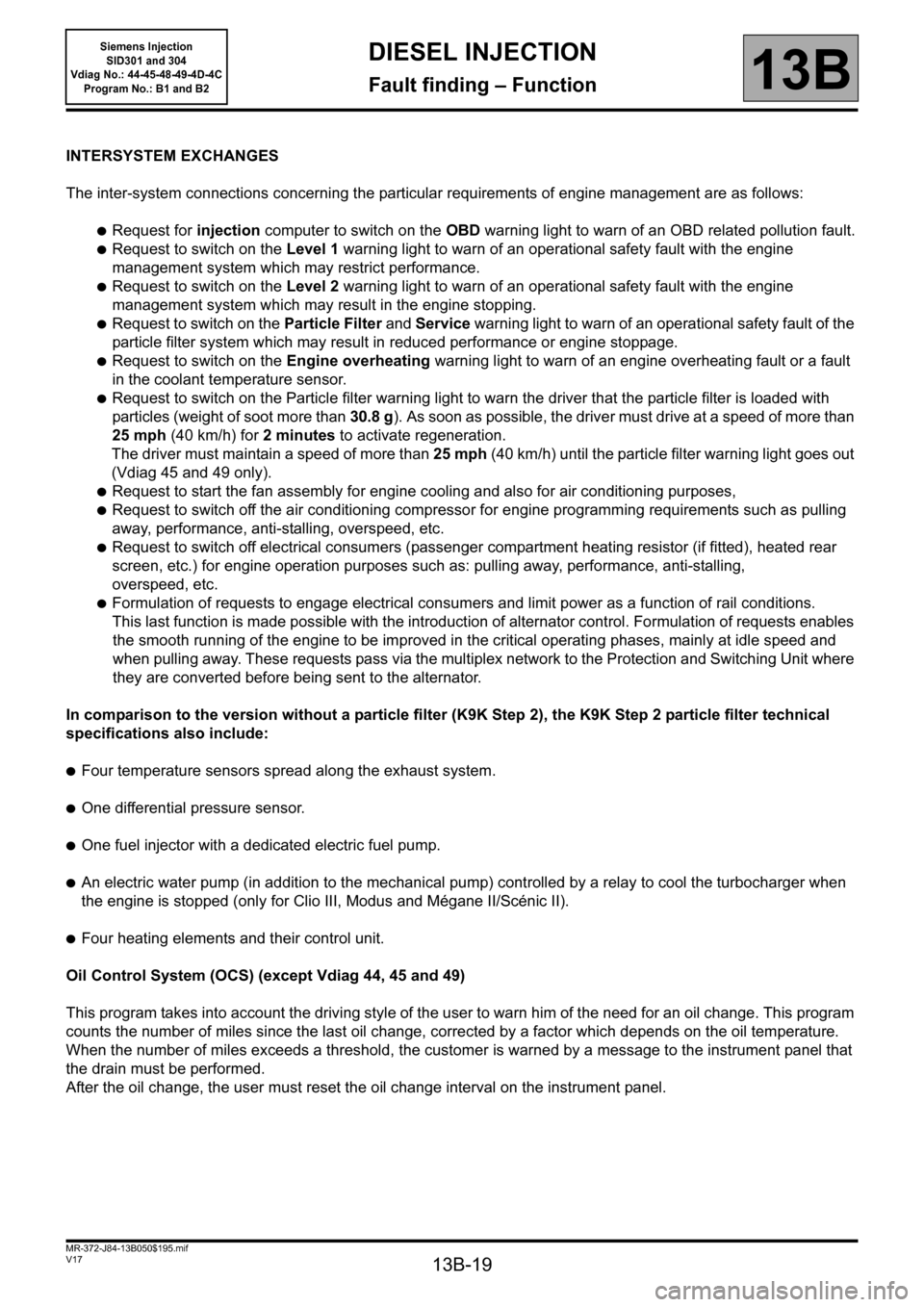
13B-19
MR-372-J84-13B050$195.mif
V17
Siemens Injection
SID301 and 304
Vdiag No.: 44-45-48-49-4D-4C
Program No.: B1 and B2DIESEL INJECTION
Fault finding – Function13B
INTERSYSTEM EXCHANGES
The inter-system connections concerning the particular requirements of engine management are as follows:
●Request for injection computer to switch on the OBD warning light to warn of an OBD related pollution fault.
●Request to switch on the Level 1 warning light to warn of an operational safety fault with the engine
management system which may restrict performance.
●Request to switch on the Level 2 warning light to warn of an operational safety fault with the engine
management system which may result in the engine stopping.
●Request to switch on the Particle Filter and Service warning light to warn of an operational safety fault of the
particle filter system which may result in reduced performance or engine stoppage.
●Request to switch on the Engine overheating warning light to warn of an engine overheating fault or a fault
in the coolant temperature sensor.
●Request to switch on the Particle filter warning light to warn the driver that the particle filter is loaded with
particles (weight of soot more than 30.8 g). As soon as possible, the driver must drive at a speed of more than
25 mph (40 km/h) for 2 minutes to activate regeneration.
The driver must maintain a speed of more than 25 mph (40 km/h) until the particle filter warning light goes out
(Vdiag 45 and 49 only).
●Request to start the fan assembly for engine cooling and also for air conditioning purposes,
●Request to switch off the air conditioning compressor for engine programming requirements such as pulling
away, performance, anti-stalling, overspeed, etc.
●Request to switch off electrical consumers (passenger compartment heating resistor (if fitted), heated rear
screen, etc.) for engine operation purposes such as: pulling away, performance, anti-stalling,
overspeed, etc.
●Formulation of requests to engage electrical consumers and limit power as a function of rail conditions.
This last function is made possible with the introduction of alternator control. Formulation of requests enables
the smooth running of the engine to be improved in the critical operating phases, mainly at idle speed and
when pulling away. These requests pass via the multiplex network to the Protection and Switching Unit where
they are converted before being sent to the alternator.
In comparison to the version without a particle filter (K9K Step 2), the K9K Step 2 particle filter technical
specifications also include:
●Four temperature sensors spread along the exhaust system.
●One differential pressure sensor.
●One fuel injector with a dedicated electric fuel pump.
●An electric water pump (in addition to the mechanical pump) controlled by a relay to cool the turbocharger when
the engine is stopped (only for Clio III, Modus and Mégane II/Scénic II).
●Four heating elements and their control unit.
Oil Control System (OCS) (except Vdiag 44, 45 and 49)
This program takes into account the driving style of the user to warn him of the need for an oil change. This program
counts the number of miles since the last oil change, corrected by a factor which depends on the oil temperature.
When the number of miles exceeds a threshold, the customer is warned by a message to the instrument panel that
the drain must be performed.
After the oil change, the user must reset the oil change interval on the instrument panel.
Page 20 of 329
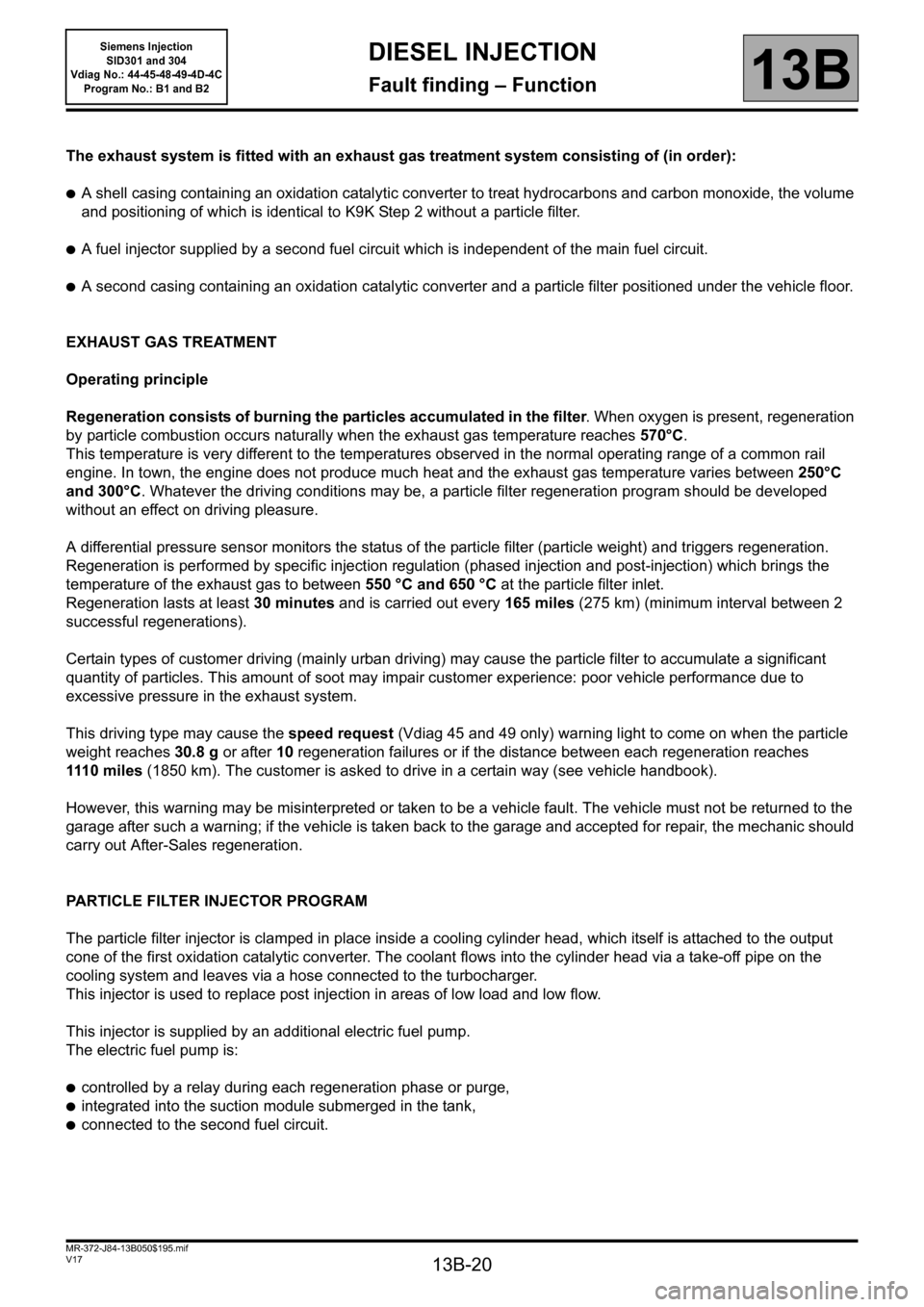
13B-20
MR-372-J84-13B050$195.mif
V17
Siemens Injection
SID301 and 304
Vdiag No.: 44-45-48-49-4D-4C
Program No.: B1 and B2DIESEL INJECTION
Fault finding – Function13B
The exhaust system is fitted with an exhaust gas treatment system consisting of (in order):
●A shell casing containing an oxidation catalytic converter to treat hydrocarbons and carbon monoxide, the volume
and positioning of which is identical to K9K Step 2 without a particle filter.
●A fuel injector supplied by a second fuel circuit which is independent of the main fuel circuit.
●A second casing containing an oxidation catalytic converter and a particle filter positioned under the vehicle floor.
EXHAUST GAS TREATMENT
Operating principle
Regeneration consists of burning the particles accumulated in the filter. When oxygen is present, regeneration
by particle combustion occurs naturally when the exhaust gas temperature reaches 570°C.
This temperature is very different to the temperatures observed in the normal operating range of a common rail
engine. In town, the engine does not produce much heat and the exhaust gas temperature varies between 250°C
and 300°C. Whatever the driving conditions may be, a particle filter regeneration program should be developed
without an effect on driving pleasure.
A differential pressure sensor monitors the status of the particle filter (particle weight) and triggers regeneration.
Regeneration is performed by specific injection regulation (phased injection and post-injection) which brings the
temperature of the exhaust gas to between 550 °C and 650 °C at the particle filter inlet.
Regeneration lasts at least 30 minutes and is carried out every 165 miles (275 km) (minimum interval between 2
successful regenerations).
Certain types of customer driving (mainly urban driving) may cause the particle filter to accumulate a significant
quantity of particles. This amount of soot may impair customer experience: poor vehicle performance due to
excessive pressure in the exhaust system.
This driving type may cause the speed request (Vdiag 45 and 49 only) warning light to come on when the particle
weight reaches 30.8 g or after 10 regeneration failures or if the distance between each regeneration reaches
111 0 m il es (1850 km). The customer is asked to drive in a certain way (see vehicle handbook).
However, this warning may be misinterpreted or taken to be a vehicle fault. The vehicle must not be returned to the
garage after such a warning; if the vehicle is taken back to the garage and accepted for repair, the mechanic should
carry out After-Sales regeneration.
PARTICLE FILTER INJECTOR PROGRAM
The particle filter injector is clamped in place inside a cooling cylinder head, which itself is attached to the output
cone of the first oxidation catalytic converter. The coolant flows into the cylinder head via a take-off pipe on the
cooling system and leaves via a hose connected to the turbocharger.
This injector is used to replace post injection in areas of low load and low flow.
This injector is supplied by an additional electric fuel pump.
The electric fuel pump is:
●controlled by a relay during each regeneration phase or purge,
●integrated into the suction module submerged in the tank,
●connected to the second fuel circuit.
Page 23 of 329
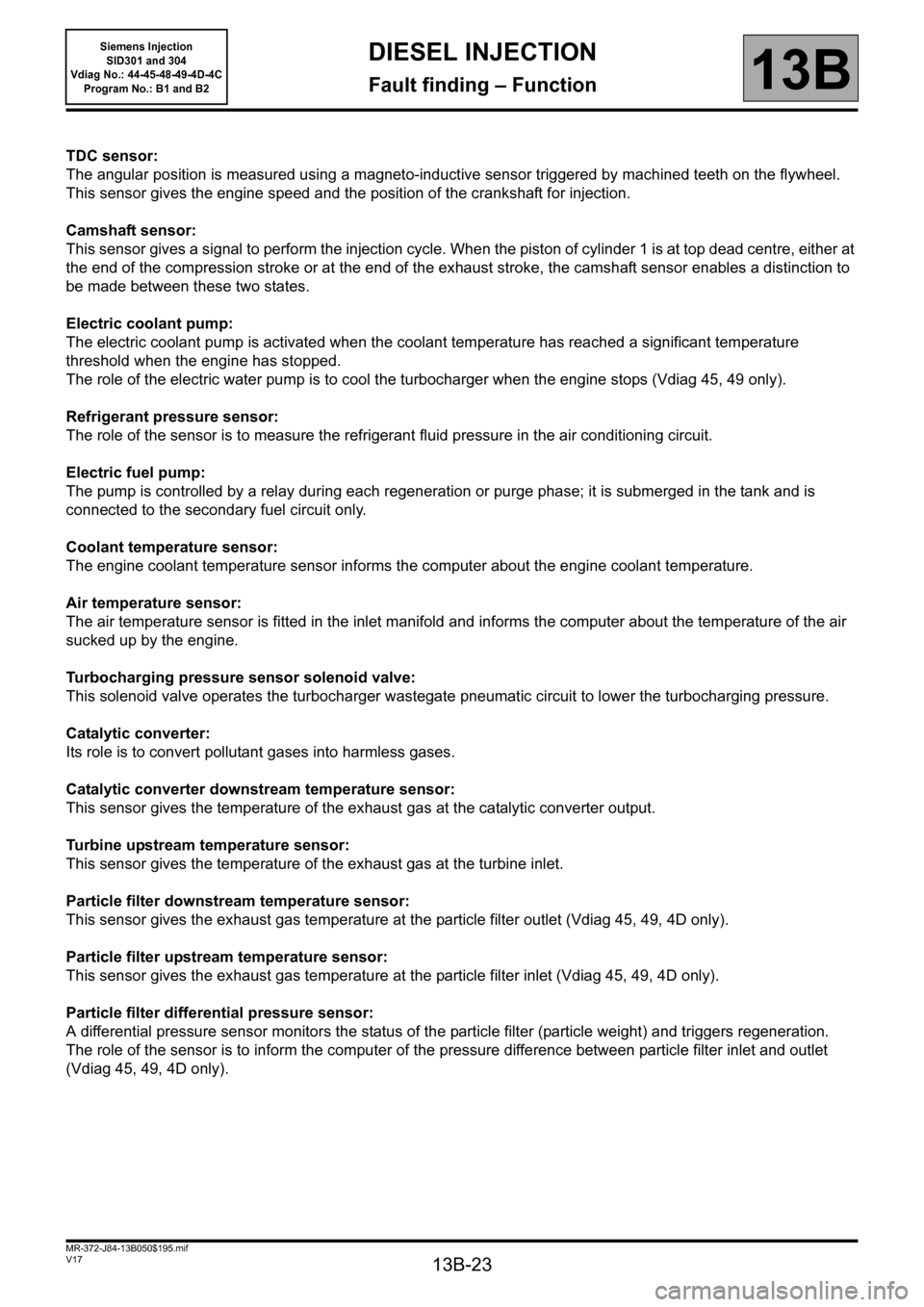
13B-23
MR-372-J84-13B050$195.mif
V17
Siemens Injection
SID301 and 304
Vdiag No.: 44-45-48-49-4D-4C
Program No.: B1 and B2DIESEL INJECTION
Fault finding – Function13B
TDC sensor:
The angular position is measured using a magneto-inductive sensor triggered by machined teeth on the flywheel.
This sensor gives the engine speed and the position of the crankshaft for injection.
Camshaft sensor:
This sensor gives a signal to perform the injection cycle. When the piston of cylinder 1 is at top dead centre, either at
the end of the compression stroke or at the end of the exhaust stroke, the camshaft sensor enables a distinction to
be made between these two states.
Electric coolant pump:
The electric coolant pump is activated when the coolant temperature has reached a significant temperature
threshold when the engine has stopped.
The role of the electric water pump is to cool the turbocharger when the engine stops (Vdiag 45, 49 only).
Refrigerant pressure sensor:
The role of the sensor is to measure the refrigerant fluid pressure in the air conditioning circuit.
Electric fuel pump:
The pump is controlled by a relay during each regeneration or purge phase; it is submerged in the tank and is
connected to the secondary fuel circuit only.
Coolant temperature sensor:
The engine coolant temperature sensor informs the computer about the engine coolant temperature.
Air temperature sensor:
The air temperature sensor is fitted in the inlet manifold and informs the computer about the temperature of the air
sucked up by the engine.
Turbocharging pressure sensor solenoid valve:
This solenoid valve operates the turbocharger wastegate pneumatic circuit to lower the turbocharging pressure.
Catalytic converter:
Its role is to convert pollutant gases into harmless gases.
Catalytic converter downstream temperature sensor:
This sensor gives the temperature of the exhaust gas at the catalytic converter output.
Turbine upstream temperature sensor:
This sensor gives the temperature of the exhaust gas at the turbine inlet.
Particle filter downstream temperature sensor:
This sensor gives the exhaust gas temperature at the particle filter outlet (Vdiag 45, 49, 4D only).
Particle filter upstream temperature sensor:
This sensor gives the exhaust gas temperature at the particle filter inlet (Vdiag 45, 49, 4D only).
Particle filter differential pressure sensor:
A differential pressure sensor monitors the status of the particle filter (particle weight) and triggers regeneration.
The role of the sensor is to inform the computer of the pressure difference between particle filter inlet and outlet
(Vdiag 45, 49, 4D only).
Page 24 of 329
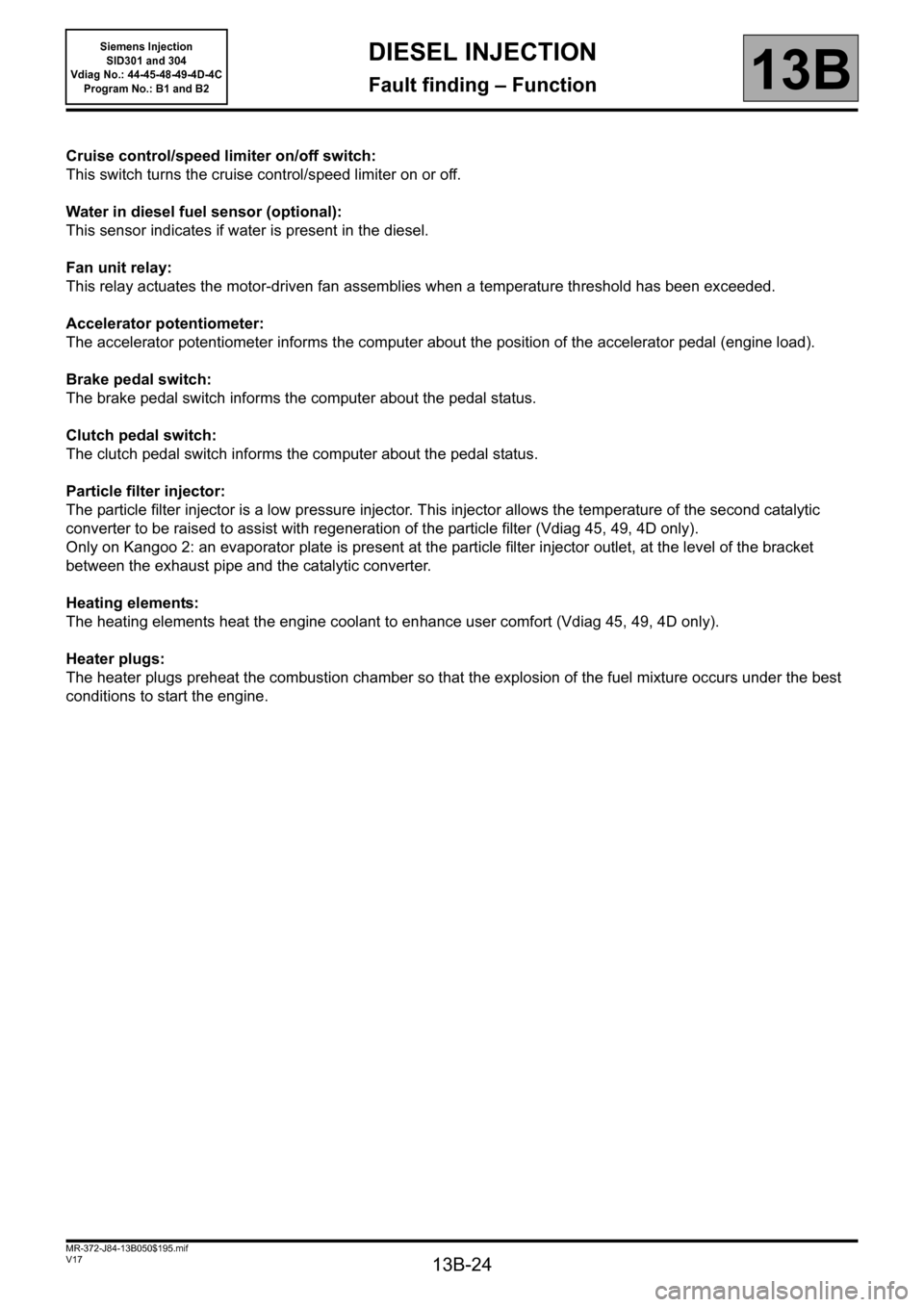
13B-24
MR-372-J84-13B050$195.mif
V17
Siemens Injection
SID301 and 304
Vdiag No.: 44-45-48-49-4D-4C
Program No.: B1 and B2DIESEL INJECTION
Fault finding – Function13B
Cruise control/speed limiter on/off switch:
This switch turns the cruise control/speed limiter on or off.
Water in diesel fuel sensor (optional):
This sensor indicates if water is present in the diesel.
Fan unit relay:
This relay actuates the motor-driven fan assemblies when a temperature threshold has been exceeded.
Accelerator potentiometer:
The accelerator potentiometer informs the computer about the position of the accelerator pedal (engine load).
Brake pedal switch:
The brake pedal switch informs the computer about the pedal status.
Clutch pedal switch:
The clutch pedal switch informs the computer about the pedal status.
Particle filter injector:
The particle filter injector is a low pressure injector. This injector allows the temperature of the second catalytic
converter to be raised to assist with regeneration of the particle filter (Vdiag 45, 49, 4D only).
Only on Kangoo 2: an evaporator plate is present at the particle filter injector outlet, at the level of the bracket
between the exhaust pipe and the catalytic converter.
Heating elements:
The heating elements heat the engine coolant to enhance user comfort (Vdiag 45, 49, 4D only).
Heater plugs:
The heater plugs preheat the combustion chamber so that the explosion of the fuel mixture occurs under the best
conditions to start the engine.
Page 31 of 329
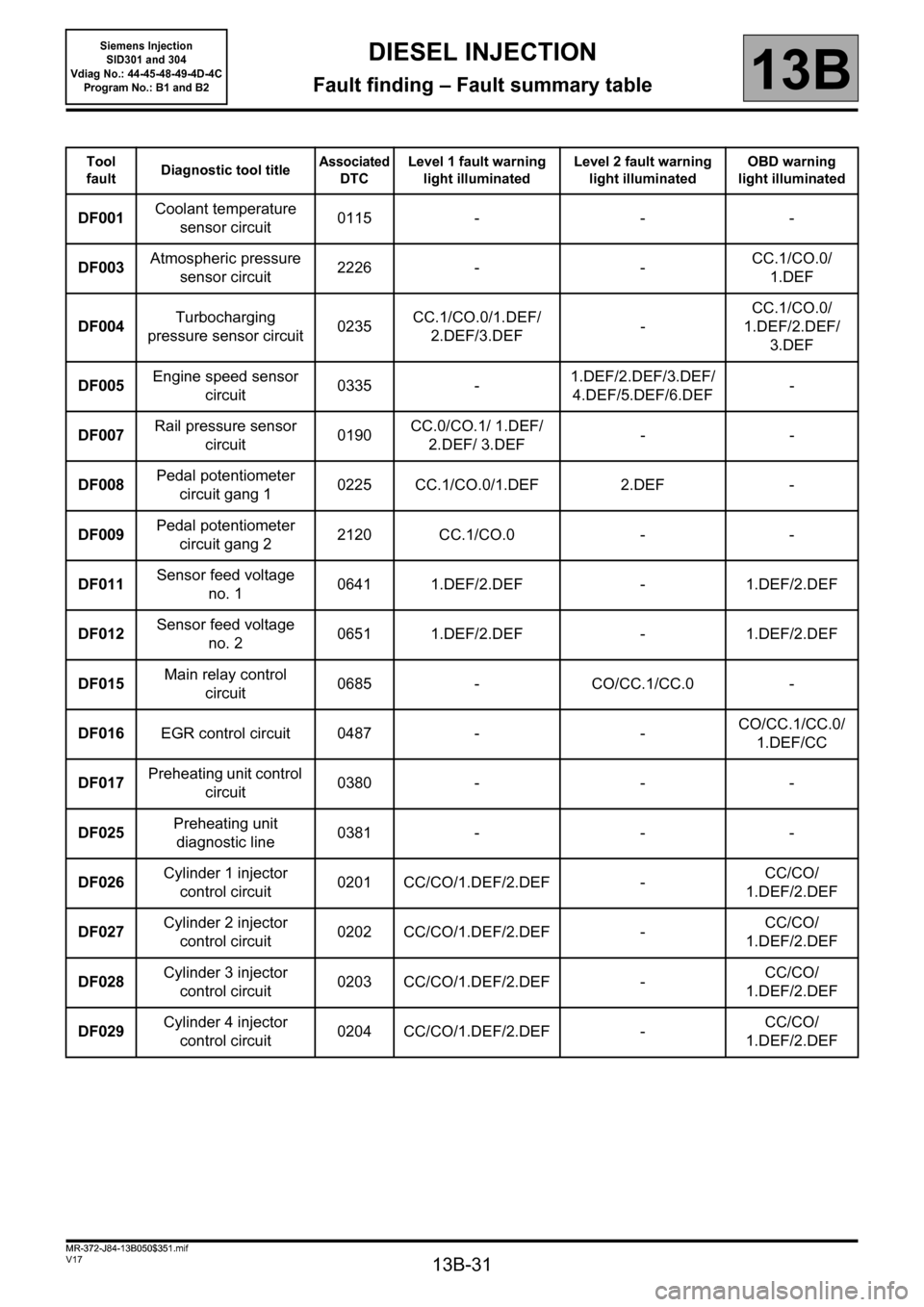
13B-31
MR-372-J84-13B050$351.mif
V17
13B
DIESEL INJECTION
Fault finding – Fault summary table
Tool
faultDiagnostic tool titleAssociated
DTCLevel 1 fault warning
light illuminatedLevel 2 fault warning
light illuminatedOBD warning
light illuminated
DF001Coolant temperature
sensor circuit0115 - - -
DF003Atmospheric pressure
sensor circuit2226 - -CC.1/CO.0/
1.DEF
DF004Turbocharging
pressure sensor circuit0235CC.1/CO.0/1.DEF/
2.DEF/3.DEF-CC.1/CO.0/
1.DEF/2.DEF/
3.DEF
DF005Engine speed sensor
circuit0335 -1.DEF/2.DEF/3.DEF/
4.DEF/5.DEF/6.DEF-
DF007Rail pressure sensor
circuit0190CC.0/CO.1/ 1.DEF/
2.DEF/ 3.DEF--
DF008Pedal potentiometer
circuit gang 10225 CC.1/CO.0/1.DEF 2.DEF -
DF009Pedal potentiometer
circuit gang 22120 CC.1/CO.0 - -
DF011Sensor feed voltage
no. 10641 1.DEF/2.DEF - 1.DEF/2.DEF
DF012Sensor feed voltage
no. 20651 1.DEF/2.DEF - 1.DEF/2.DEF
DF015Main relay control
circuit0685 - CO/CC.1/CC.0 -
DF016EGR control circuit 0487 - -CO/CC.1/CC.0/
1.DEF/CC
DF017Preheating unit control
circuit0380 - - -
DF025Preheating unit
diagnostic line0381 - - -
DF026Cylinder 1 injector
control circuit0201 CC/CO/1.DEF/2.DEF -CC/CO/
1.DEF/2.DEF
DF027Cylinder 2 injector
control circuit0202 CC/CO/1.DEF/2.DEF -CC/CO/
1.DEF/2.DEF
DF028Cylinder 3 injector
control circuit0203 CC/CO/1.DEF/2.DEF -CC/CO/
1.DEF/2.DEF
DF029Cylinder 4 injector
control circuit0204 CC/CO/1.DEF/2.DEF -CC/CO/
1.DEF/2.DEF
MR-372-J84-13B050$351.mif
Siemens Injection
SID301 and 304
Vdiag No.: 44-45-48-49-4D-4C
Program No.: B1 and B2
Page 32 of 329
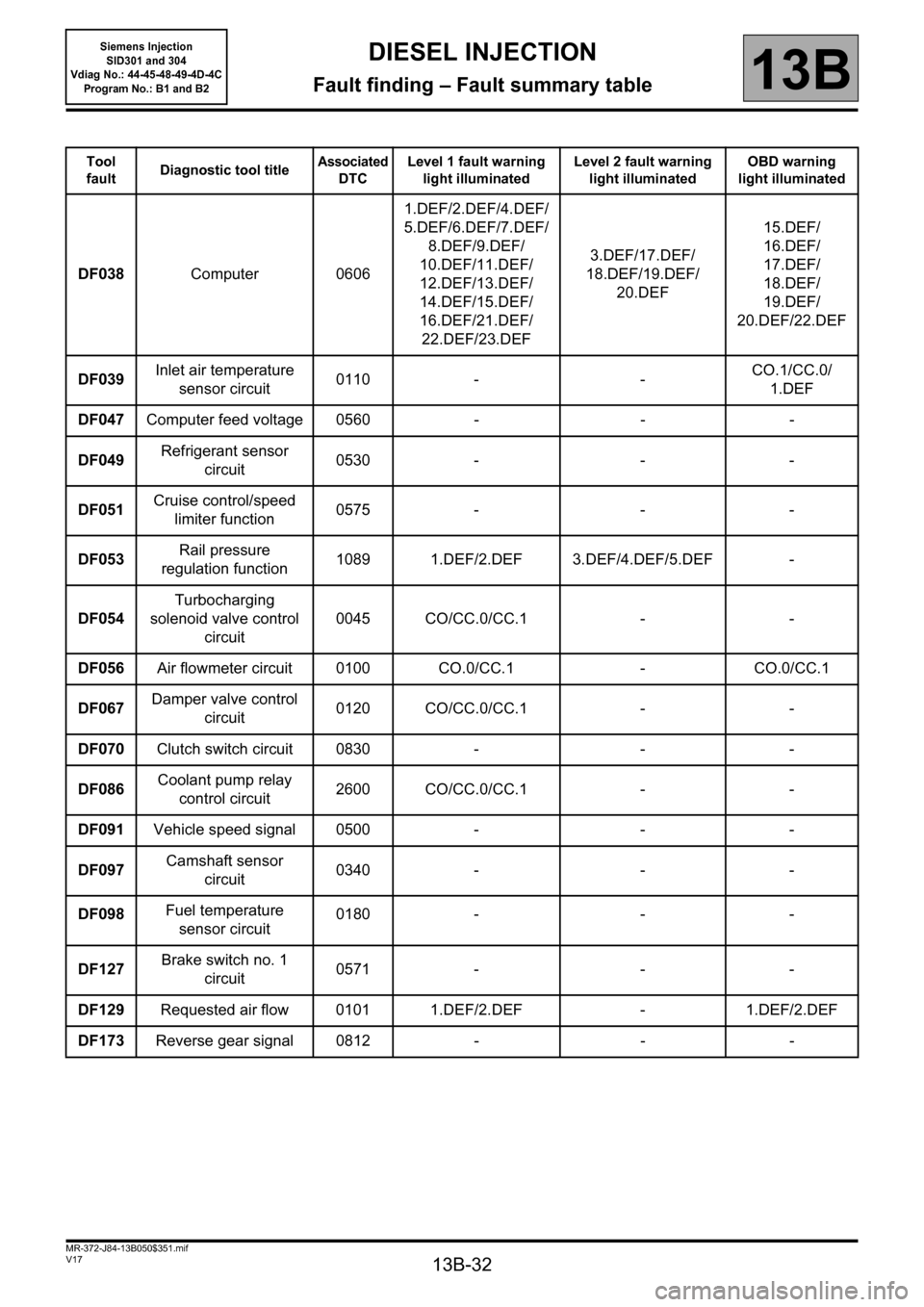
13B-32
MR-372-J84-13B050$351.mif
V17
Siemens Injection
SID301 and 304
Vdiag No.: 44-45-48-49-4D-4C
Program No.: B1 and B2DIESEL INJECTION
Fault finding – Fault summary table13B
Tool
faultDiagnostic tool titleAssociated
DTCLevel 1 fault warning
light illuminatedLevel 2 fault warning
light illuminatedOBD warning
light illuminated
DF038Computer 06061.DEF/2.DEF/4.DEF/
5.DEF/6.DEF/7.DEF/
8.DEF/9.DEF/
10.DEF/11.DEF/
12.DEF/13.DEF/
14.DEF/15.DEF/
16.DEF/21.DEF/
22.DEF/23.DEF3.DEF/17.DEF/
18.DEF/19.DEF/
20.DEF15.DEF/
16.DEF/
17.DEF/
18.DEF/
19.DEF/
20.DEF/22.DEF
DF039Inlet air temperature
sensor circuit0110 - -CO.1/CC.0/
1.DEF
DF047Computer feed voltage 0560 - - -
DF049Refrigerant sensor
circuit0530 - - -
DF051Cruise control/speed
limiter function0575 - - -
DF053Rail pressure
regulation function1089 1.DEF/2.DEF 3.DEF/4.DEF/5.DEF -
DF054Turbocharging
solenoid valve control
circuit0045 CO/CC.0/CC.1 - -
DF056Air flowmeter circuit 0100 CO.0/CC.1 - CO.0/CC.1
DF067Damper valve control
circuit0120 CO/CC.0/CC.1 - -
DF070Clutch switch circuit 0830 - - -
DF086Coolant pump relay
control circuit2600 CO/CC.0/CC.1 - -
DF091Vehicle speed signal 0500 - - -
DF097Camshaft sensor
circuit0340 - - -
DF098Fuel temperature
sensor circuit0180 - - -
DF127Brake switch no. 1
circuit0571 - - -
DF129Requested air flow 0101 1.DEF/2.DEF - 1.DEF/2.DEF
DF173Reverse gear signal 0812 - - -
Page 33 of 329
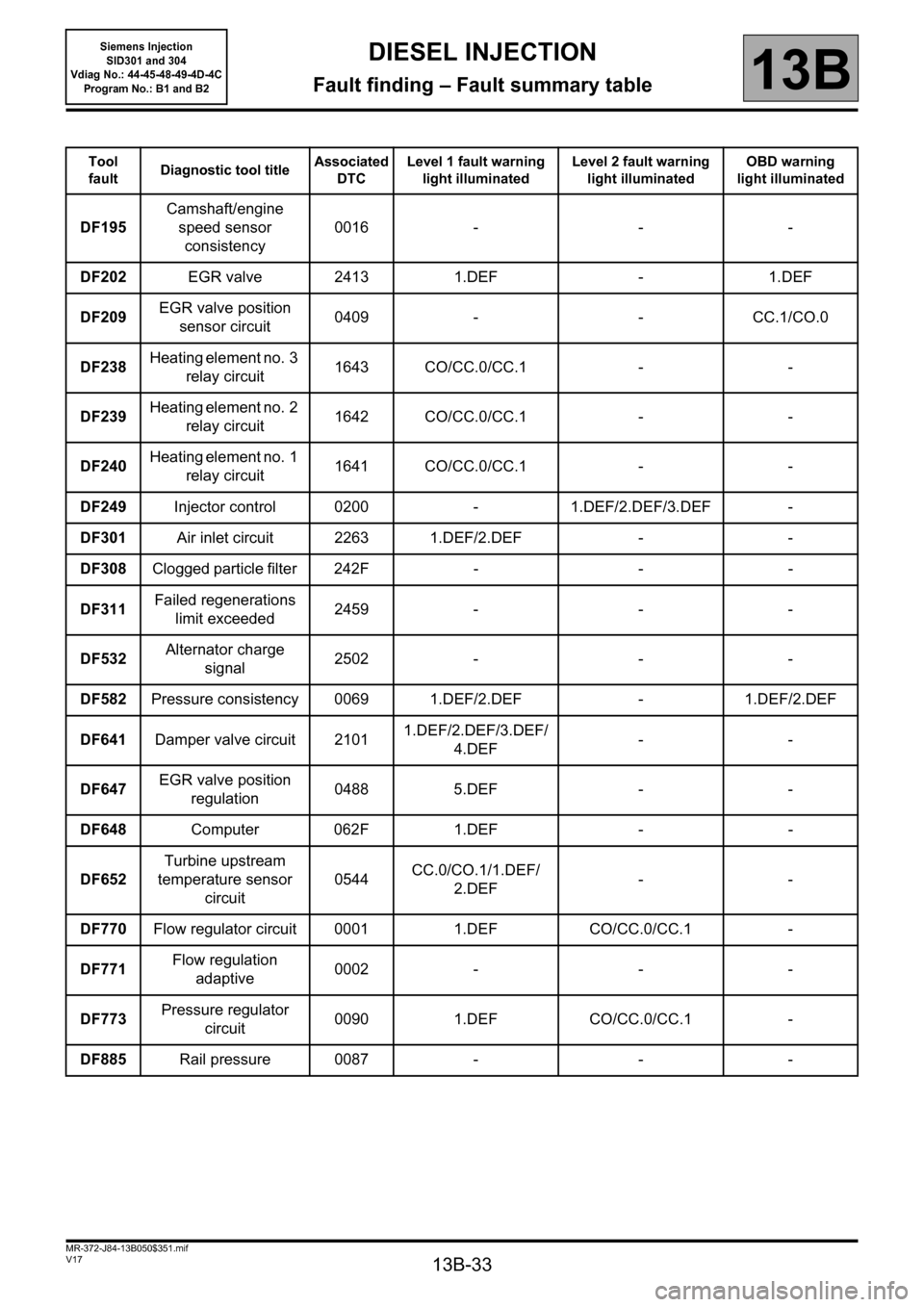
13B-33
MR-372-J84-13B050$351.mif
V17
Siemens Injection
SID301 and 304
Vdiag No.: 44-45-48-49-4D-4C
Program No.: B1 and B2DIESEL INJECTION
Fault finding – Fault summary table13B
Tool
faultDiagnostic tool titleAssociated
DTCLevel 1 fault warning
light illuminatedLevel 2 fault warning
light illuminatedOBD warning
light illuminated
DF195Camshaft/engine
speed sensor
consistency0016 - - -
DF202EGR valve 2413 1.DEF - 1.DEF
DF209EGR valve position
sensor circuit0409 - - CC.1/CO.0
DF238Heating element no. 3
relay circuit 1643 CO/CC.0/CC.1 - -
DF239Heating element no. 2
relay circuit 1642 CO/CC.0/CC.1 - -
DF240Heating element no. 1
relay circuit 1641 CO/CC.0/CC.1 - -
DF249Injector control 0200 - 1.DEF/2.DEF/3.DEF -
DF301Air inlet circuit 2263 1.DEF/2.DEF - -
DF308Clogged particle filter 242F - - -
DF311Failed regenerations
limit exceeded 2459 - - -
DF532Alternator charge
signal2502 - - -
DF582Pressure consistency 0069 1.DEF/2.DEF - 1.DEF/2.DEF
DF641Damper valve circuit 21011.DEF/2.DEF/3.DEF/
4.DEF--
DF647EGR valve position
regulation0488 5.DEF - -
DF648Computer 062F 1.DEF - -
DF652Turbine upstream
temperature sensor
circuit 0544CC.0/CO.1/1.DEF/
2.DEF--
DF770Flow regulator circuit 0001 1.DEF CO/CC.0/CC.1 -
DF771Flow regulation
adaptive0002 - - -
DF773Pressure regulator
circuit0090 1.DEF CO/CC.0/CC.1 -
DF885Rail pressure 0087 - - -
Page 34 of 329
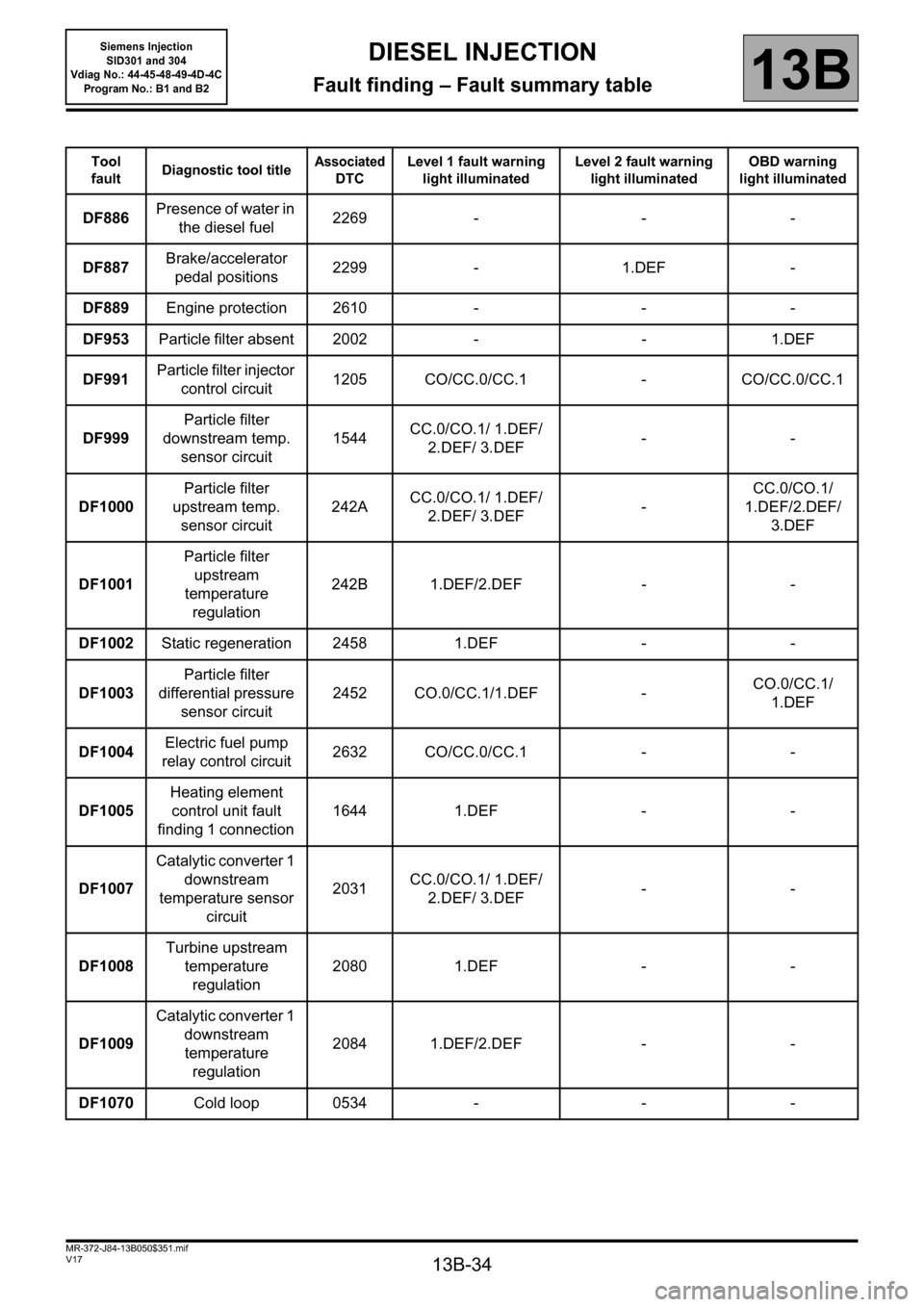
13B-34
MR-372-J84-13B050$351.mif
V17
Siemens Injection
SID301 and 304
Vdiag No.: 44-45-48-49-4D-4C
Program No.: B1 and B2DIESEL INJECTION
Fault finding – Fault summary table13B
Tool
faultDiagnostic tool titleAssociated
DTCLevel 1 fault warning
light illuminatedLevel 2 fault warning
light illuminatedOBD warning
light illuminated
DF886Presence of water in
the diesel fuel2269 - - -
DF887Brake/accelerator
pedal positions2299 - 1.DEF -
DF889Engine protection 2610 - - -
DF953Particle filter absent 2002 - - 1.DEF
DF991Particle filter injector
control circuit 1205 CO/CC.0/CC.1 - CO/CC.0/CC.1
DF999Particle filter
downstream temp.
sensor circuit1544CC.0/CO.1/ 1.DEF/
2.DEF/ 3.DEF--
DF1000Particle filter
upstream temp.
sensor circuit242ACC.0/CO.1/ 1.DEF/
2.DEF/ 3.DEF-CC.0/CO.1/
1.DEF/2.DEF/
3.DEF
DF1001Particle filter
upstream
temperature
regulation 242B 1.DEF/2.DEF - -
DF1002Static regeneration 2458 1.DEF - -
DF1003Particle filter
differential pressure
sensor circuit 2452 CO.0/CC.1/1.DEF -CO.0/CC.1/
1.DEF
DF1004Electric fuel pump
relay control circuit 2632 CO/CC.0/CC.1 - -
DF1005Heating element
control unit fault
finding 1 connection 1644 1.DEF - -
DF1007Catalytic converter 1
downstream
temperature sensor
circuit 2031CC.0/CO.1/ 1.DEF/
2.DEF/ 3.DEF--
DF1008Turbine upstream
temperature
regulation 2080 1.DEF - -
DF1009Catalytic converter 1
downstream
temperature
regulation 2084 1.DEF/2.DEF - -
DF1070Cold loop 0534 - - -
Page 48 of 329
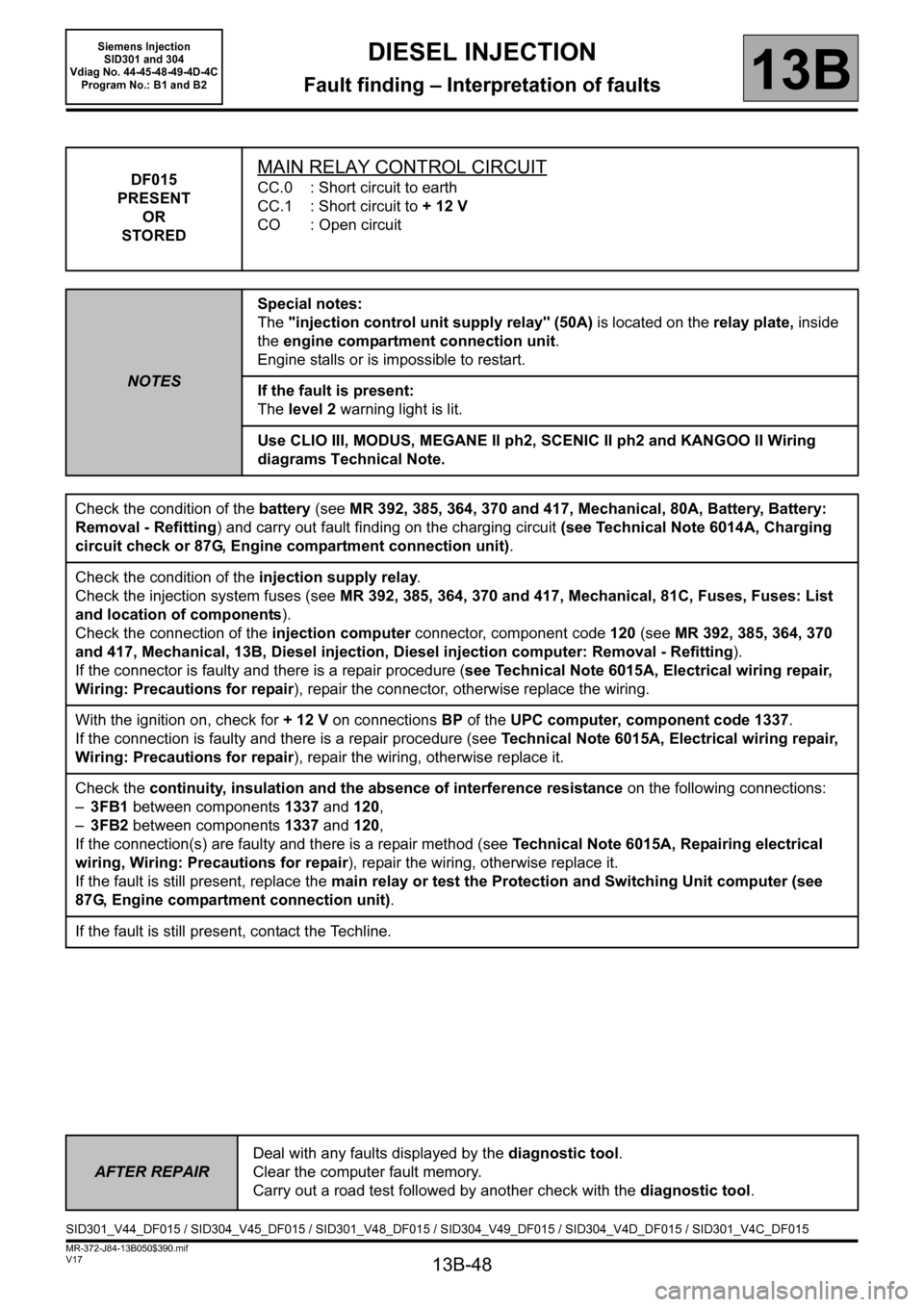
13B-48
MR-372-J84-13B050$390.mif
V17
DIESEL INJECTION
Fault finding – Interpretation of faults
Siemens Injection
SID301 and 304
Vdiag No. 44-45-48-49-4D-4C
Program No.: B1 and B2
13B
DF015
PRESENT
OR
STOREDMAIN RELAY CONTROL CIRCUIT
CC.0 : Short circuit to earth
CC.1 : Short circuit to + 12 V
CO : Open circuit
NOTESSpecial notes:
The "injection control unit supply relay" (50A) is located on the relay plate, inside
the engine compartment connection unit.
Engine stalls or is impossible to restart.
If the fault is present:
The level 2 warning light is lit.
Use CLIO III, MODUS, MEGANE II ph2, SCENIC II ph2 and KANGOO II Wiring
diagrams Technical Note.
Check the condition of the battery (see MR 392, 385, 364, 370 and 417, Mechanical, 80A, Battery, Battery:
Removal - Refitting) and carry out fault finding on the charging circuit (see Technical Note 6014A, Charging
circuit check or 87G, Engine compartment connection unit).
Check the condition of the injection supply relay.
Check the injection system fuses (see MR 392, 385, 364, 370 and 417, Mechanical, 81C, Fuses, Fuses: List
and location of components).
Check the connection of the injection computer connector, component code120 (see MR 392, 385, 364, 370
and 417, Mechanical, 13B, Diesel injection, Diesel injection computer: Removal - Refitting).
If the connector is faulty and there is a repair procedure (see Technical Note 6015A, Electrical wiring repair,
Wiring: Precautions for repair), repair the connector, otherwise replace the wiring.
With the ignition on, check for + 12 V on connections BP of the UPC computer, component code 1337.
If the connection is faulty and there is a repair procedure (see Technical Note 6015A, Electrical wiring repair,
Wiring: Precautions for repair), repair the wiring, otherwise replace it.
Check the continuity, insulation and the absence of interference resistance on the following connections:
–3FB1 between components 1337 and 120,
–3FB2 between components 1337 and 120,
If the connection(s) are faulty and there is a repair method (see Technical Note 6015A, Repairing electrical
wiring, Wiring: Precautions for repair), repair the wiring, otherwise replace it.
If the fault is still present, replace the main relay or test the Protection and Switching Unit computer (see
87G, Engine compartment connection unit).
If the fault is still present, contact the Techline.
AFTER REPAIRDeal with any faults displayed by the diagnostic tool.
Clear the computer fault memory.
Carry out a road test followed by another check with the diagnostic tool.
SID301_V44_DF015 / SID304_V45_DF015 / SID301_V48_DF015 / SID304_V49_DF015 / SID304_V4D_DF015 / SID301_V4C_DF015